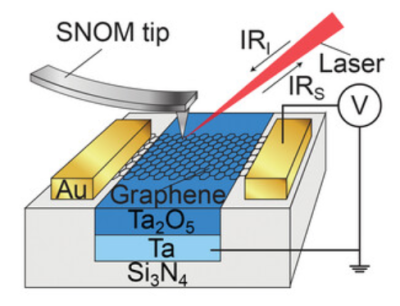Current events
Talk today at 11:30 by Christian Volk!
News 30.09.2025
Bilayer Graphene Quantum Dots at QTech-Bp in Budapest
Site Content:
News 04.01.2024
New publication: In Operando Near-Field Optical Investigation of Memristive Ta2O5 Thin Film Devices with a Graphene Top Electrode

Adv. Funct. Mat. 2312980 (2024) Resistive switching devices based on metal oxides are candidates for nonvolatile memory storage. They often rely on the valence change mechanism, the field-induced movement of donor ions leading to nanoscale conductive paths in filamentary-type devices. Devices usually consist of a transition metal oxide like Ta2O5 sandwiched between two metal electrodes. Critical parameters of the devices, such as cycle-to-cycle variability, Roff/Ron ratio, and endurance depend on the morphology and composition of the filaments. However, investigating filaments on the nanoscale is cumbersome, and commonly applied techniques such as conductive atomic force or transmission electron microscopy require delaminating the metal top electrode, inhibiting in operando investigations over many switching cycles. Here, the authors use infrared scattering-type scanning near-field optical microscopy (s-SNOM) to investigate resistive switching in Ta2O5 films with a graphene top electrode in operando and reveal individual filaments on the device level. By selecting an appropriate illumination frequency, the authors can trace the evolution of filaments and the joule heating-induced retraction of the top electrode until device failure. s-SNOM promises a deeper understanding of resistive switching devices’ microscopic switching behavior and applies to a wide range of resistive switching oxides, such as HfO2, SrTiO3, and SiO2.
